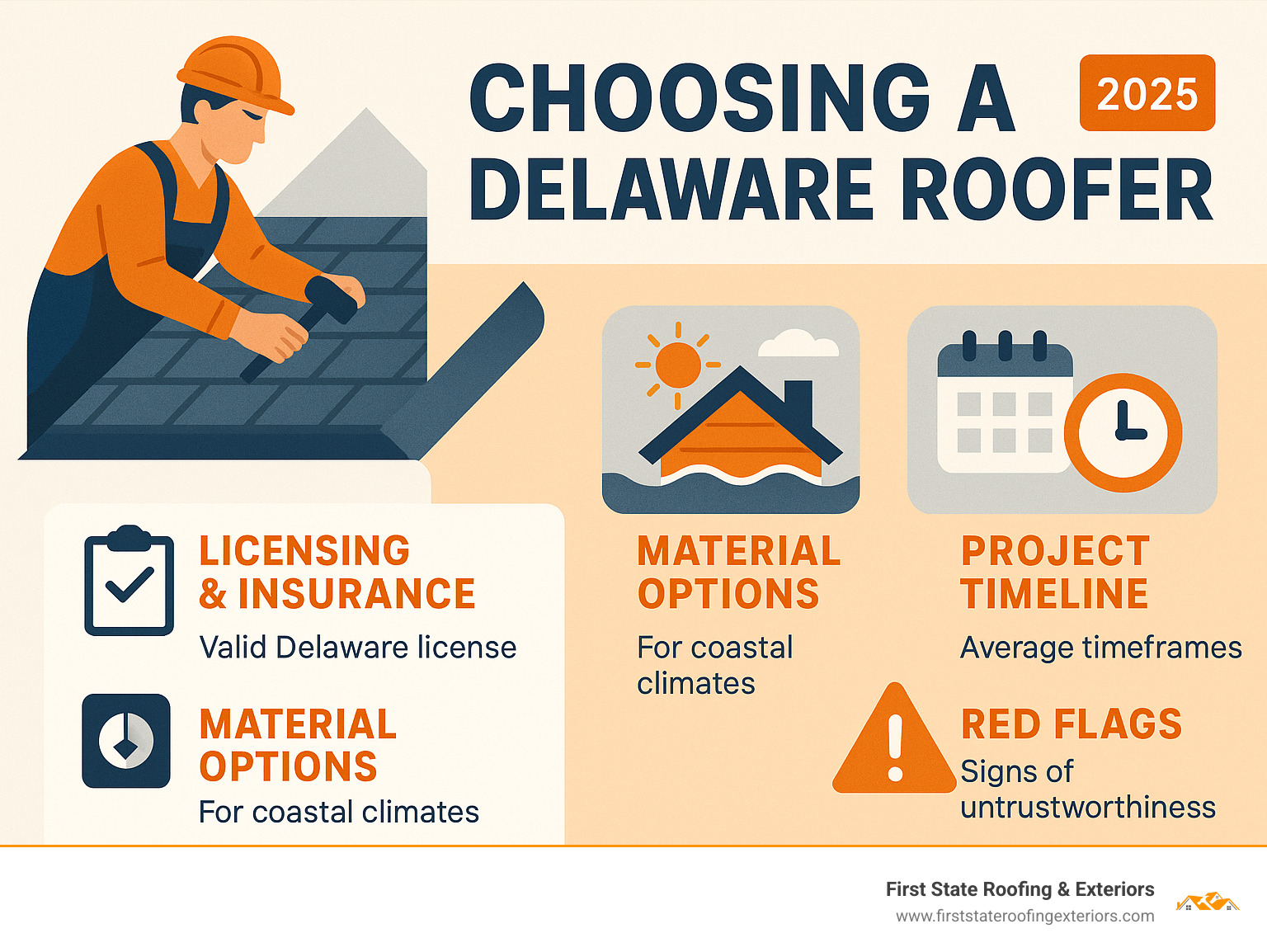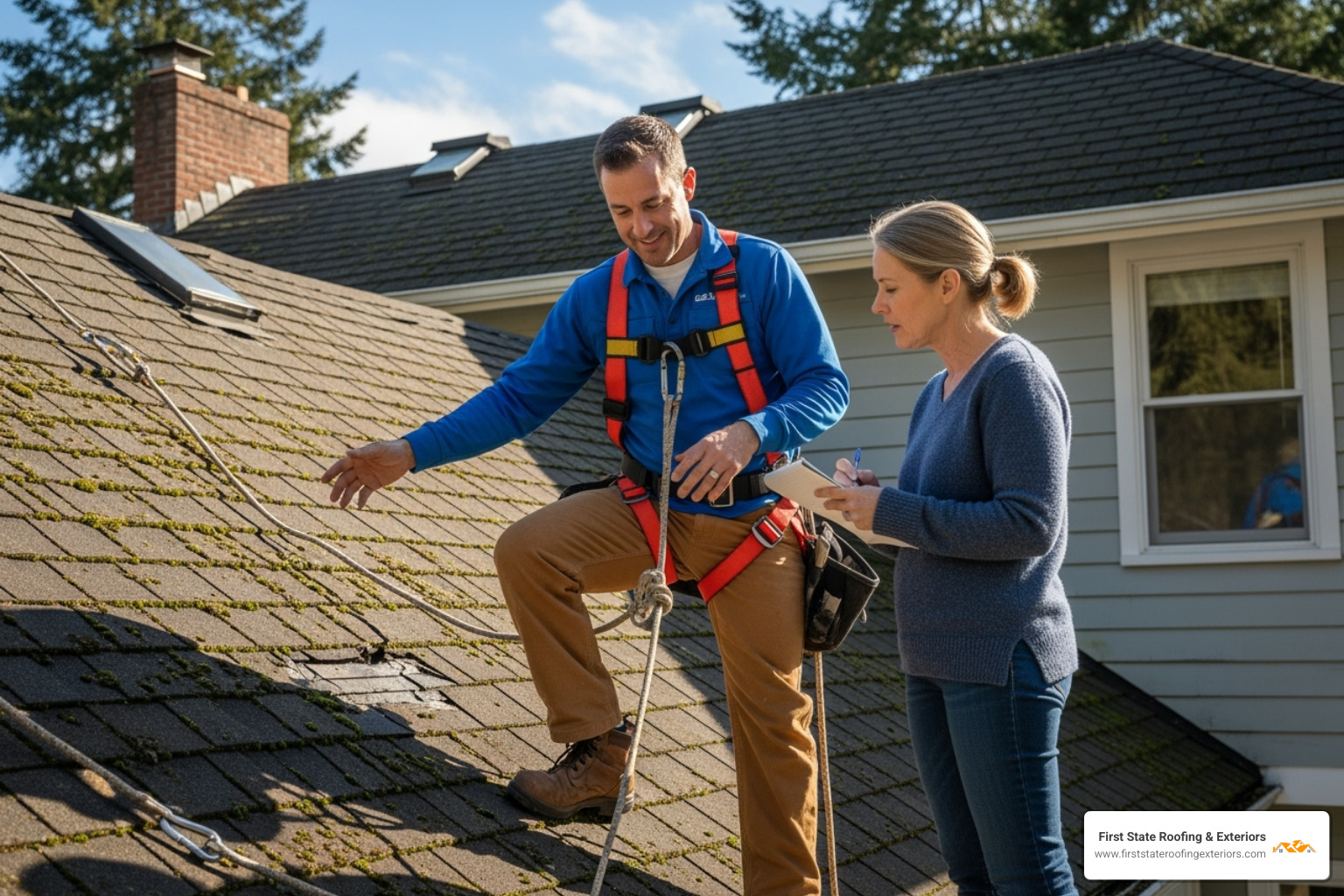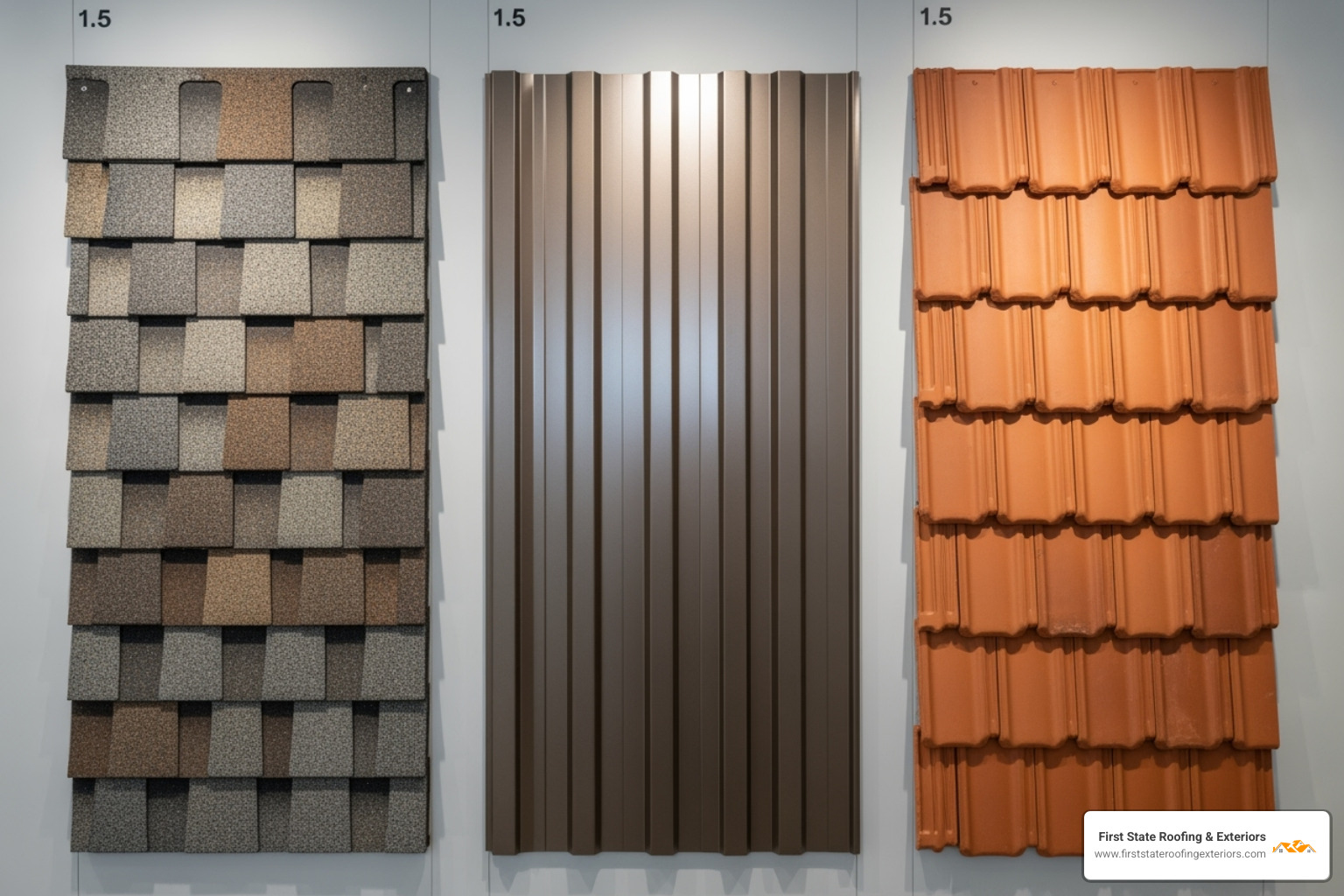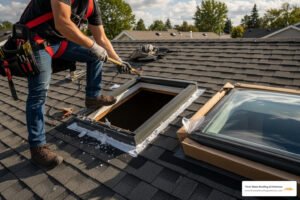Why Finding the Right Delaware Roofer Matters
Finding a trustworthy Delaware roofer can feel overwhelming, especially when your home’s safety is on the line. From navigating storm damage after a Nor’easter to replacing an aging roof, the stakes are high. This guide provides a comprehensive checklist for Delaware homeowners, ensuring you partner with a reliable professional who understands the unique challenges of our state’s climate. If you’re looking for a dependable team with proven local expertise, starting with a trusted Delaware roofing company is your best move.
Top Delaware Roofer Selection Criteria:
- Licensed and insured with Delaware state credentials
- GAF Master Elite certification for superior warranties
- Local expertise with Delaware’s coastal climate challenges
- Positive customer reviews and community reputation
- Transparent pricing with detailed written estimates
- Storm damage experience for insurance claim assistance
- Quality materials suited for high winds and salt air
Delaware’s unique coastal climate presents specific challenges that require experienced professionals. High winds, salt air, heavy snow loads, and severe storms demand roofing solutions that can withstand these conditions. The research shows that homeowners across the state have faced issues ranging from persistent leaks to complete storm damage, making the choice of contractor crucial.
As Richard McCain, Owner and President of First State Roofing & Exteriors, I’ve spent over 20 years helping Delaware homeowners steer these challenges as a trusted Delaware roofer. My team and I understand the specific requirements of our state’s climate and building codes, ensuring every project meets the highest standards for durability and protection. Call us at (302) 222-4065 to schedule your free estimate and inspection.

Delaware roofer vocab to learn:
1. Know the Telltale Signs: When to Call a Roofer
Your roof has a way of whispering before it screams. As a trusted Delaware roofer, I’ve seen too many homeowners ignore these early warning signs, only to face emergency repairs during the next storm. The good news? Most roofing problems give you plenty of notice if you know what to look for.
Visible damage is your roof’s most obvious cry for help. Missing shingles after a windstorm are hard to miss, but the subtler signs often go unnoticed. Shingles that curl up at the edges like potato chips, or buckle in the middle, are telling you they’ve reached the end of their useful life. These compromised shingles leave your underlayment exposed to Delaware’s harsh coastal elements.
The age of your roof matters more than you might think. Even if your 25-year-old asphalt shingle roof looks decent from the ground, it’s like a car with 200,000 miles – it might run fine today, but key components are living on borrowed time. Most asphalt shingles last 20-30 years in our climate, and approaching that milestone means it’s time for a professional inspection.
Interior water stains on your ceiling or walls should set off immediate alarm bells. That innocent-looking brown spot represents water that’s already breached your roof’s defenses. Here’s the tricky part: water can travel surprisingly far from the actual leak point before it shows up inside your home. What looks like a small problem often signals significant damage hiding behind your walls.
Have you noticed your energy bills creeping up without explanation? Your failing roof might be the culprit. When insulation gets wet or ventilation systems become compromised, your HVAC system works overtime to maintain comfortable temperatures. A properly functioning roof system can dramatically improve your home’s energy efficiency.
Take a peek in your gutters next time you’re outside. An abundance of granules that look like coarse sand means your asphalt shingles are losing their protective coating. These granules shield your roof from UV damage, and once they’re gone, deterioration accelerates rapidly.
Curling or buckling shingles deserve special attention because they create entry points for water and wind. In Delaware’s coastal environment, even small openings can quickly become major problems when the next storm hits.
A sagging roof deck represents a serious structural emergency. Whether caused by water damage, inadequate support, or heavy snow loads, any visible dip in your roofline requires immediate professional attention. This isn’t a problem you can put off until spring.
Finally, moss or algae growth thrives in our humid Delaware summers. While not immediately dangerous, extensive growth traps moisture against your shingles and creates an environment for premature deterioration. Regular maintenance can prevent these organisms from shortening your roof’s lifespan.
If you’re seeing any of these warning signs, don’t wait for the next storm to test your roof’s limits. Our professional roofing services are designed to address problems before they become emergencies.
Common Issues for Delaware Roofs
Living between the Atlantic Ocean and Delaware Bay means our roofs face challenges that inland homeowners never encounter. The coastal weather impact isn’t just about scenic views – it’s about constant battles with salt air, high winds, and unique storm patterns.
Storm damage tops our list of concerns, and for good reason. Delaware sits right in the path of nor’easters, tropical storms, and the occasional hurricane. These weather events bring devastating combinations of high winds, torrential rain, and sometimes hail. Wind-driven rain can penetrate even well-maintained roofing systems, especially when sustained winds lift shingles or compromise flashing around chimneys and vents.
Winter brings its own set of headaches. Heavy snow loads can stress your roof’s structure, particularly if snow accumulates unevenly or isn’t properly removed. Ice dams form when melting snow refreezes at your roof’s edge, creating a barrier that forces water back under your shingles. I’ve seen ice dams cause thousands of dollars in water damage to otherwise sound homes.
Delaware’s notorious humidity creates perfect conditions for moss and algae growth. These organisms don’t just look unsightly – they hold moisture against your roof surface, accelerating material breakdown and requiring more frequent maintenance. Shaded areas and north-facing slopes are particularly susceptible.
The salt air that makes our coastal location so appealing also accelerates corrosion on metal components like flashing, gutters, and fasteners. Even if your shingles look great, failing metal components can create leak points that compromise your entire roofing system.
Understanding these climate-specific challenges is exactly why you need a local expert who knows Delaware’s unique conditions. We’ve spent decades learning how to protect homes against these particular threats. To connect with experienced professionals in your area, you can find a Delaware roofer near you who understands what your roof faces every day.
Ready to get your roof inspected by professionals who know Delaware’s climate inside and out? Call us at (302) 222-4065 to schedule your free estimate and inspection, and get peace of mind before the next storm season arrives.
2. Vet Your Options: How to Choose the Best Delaware Roofer
Choosing a Delaware roofer isn’t like picking up groceries; it’s a significant investment in your home’s protection and value. The decision you make today will affect your family’s comfort and safety for decades to come. After two decades of helping Delaware homeowners steer this process, I’ve learned that the difference between a great roofing experience and a nightmare often comes down to doing your homework upfront.
When you’re ready to move forward with a roofing project, whether it’s a complete roof replacement or repairs, taking time to properly vet your options will save you headaches, money, and stress down the road.

Credentials and Insurance
The foundation of any trustworthy roofing contractor starts with proper credentials. Any reputable Delaware roofer should be fully licensed and insured – and I mean both, not just one or the other. This isn’t optional; it’s absolutely essential for protecting yourself as a homeowner.
Delaware state licensing ensures the contractor meets minimum qualifications and understands local building codes. But insurance is equally critical. Without proper insurance, you could be held liable if a worker gets injured on your property or if something goes wrong during the project. Always ask to see current certificates of insurance, and don’t be shy about verifying them directly with the insurance company.
Look for contractors with manufacturer certifications like GAF Master Elite, CertainTeed, or Owens Corning. These aren’t participation trophies – they represent serious commitments to quality and ongoing education. Manufacturers only award these certifications to contractors who meet strict standards for workmanship, customer service, and business practices.
A strong reputation in the community speaks volumes about a contractor’s reliability. Check online reviews on multiple platforms, but a few negative reviews aren’t necessarily deal-breakers. What matters more is how the company responds to concerns and resolves issues. Look for patterns in the feedback: do customers consistently praise their communication, workmanship, and professionalism?
Positive online reviews should tell a story of satisfied customers, but be wary of companies with only glowing five-star reviews – that can sometimes indicate fake reviews. Authentic feedback includes both positives and constructive criticism, with responses from the company showing they care about customer satisfaction.
Experience and Local Expertise
Experience isn’t just about years in business, though longevity does indicate stability and customer satisfaction. What really matters is relevant experience – specifically, experience working with Delaware’s unique climate challenges and local building requirements.
A seasoned Delaware roofer should have intimate knowledge of local building codes and permit requirements. They should understand which materials perform best in our coastal environment and how to install them properly to withstand salt air, high winds, and heavy snow loads.
Experience with Delaware’s climate is crucial because what works in Arizona won’t necessarily work here. Our contractors need to understand how to handle everything from hurricane-force winds to ice dams. They should know which underlayments provide the best moisture protection and how to ensure proper ventilation in our humid summers.
Ask to see a portfolio of local work – not just photos, but actual addresses where you might be able to drive by and see their craftsmanship. A contractor who’s proud of their work will be happy to share examples, and seeing their projects in person gives you a much better sense of quality than any brochure.
Understanding GAF Master Elite Benefits
You’ll likely hear about GAF Master Elite certification during your search, and it’s worth understanding what this really means. GAF is North America’s largest roofing manufacturer, and their Master Elite program is highly selective – only about 2% of roofing contractors nationwide achieve this status.
The access to superior warranties is perhaps the most tangible benefit. GAF Master Elite contractors can offer warranties that cover both materials and workmanship for up to 25 years – protection that’s simply not available through non-certified contractors. This isn’t just marketing; it’s real financial protection for your investment.
The certification also represents a proven track record of quality. To earn and maintain Master Elite status, contractors must demonstrate excellent customer satisfaction scores, proper licensing and insurance, and commitment to ongoing education. It’s like a quality seal from the manufacturer.
Ongoing professional training ensures these contractors stay current with the latest installation techniques, safety protocols, and product innovations. The roofing industry evolves constantly, and you want a contractor who evolves with it rather than relying on outdated methods.
Most importantly, working with a GAF Master Elite contractor provides peace of mind. You’re not just hiring a local contractor; you’re partnering with someone backed by the industry’s leading manufacturer. If issues arise, you have additional recourse beyond the contractor alone.
When you’re ready to move forward with your roofing project, don’t hesitate to ask potential contractors about their certifications and what warranties they can offer. At First State Roofing & Exteriors, we’re proud to offer our customers the protection and quality that comes with proper certification and local expertise. Call us at (302) 222-4065 to schedule your free estimate and inspection and learn more about how we can protect your home.
3. Select the Right Materials for Delaware’s Climate
Choosing the right roofing material for your Delaware home is a decision that balances durability, aesthetics, and budget, all while standing up to our local weather. The best material for your neighbor might not be the best for you, so let’s explore the common types and their suitability for our region.

Popular Roofing Materials
When it comes to roofing materials in Delaware, asphalt shingles dominate the landscape for good reason. They’re cost-effective, versatile, and come in two main varieties. Traditional 3-tab shingles offer basic protection at the lowest price point, while architectural shingles (also called laminated shingles) provide a thicker, more dimensional appearance with better wind resistance. Products like GAF’s Timberline HDZ® represent the gold standard in architectural shingles, offering improved durability against our coastal winds.
Metal roofing has been gaining serious traction among Delaware homeowners, and it’s easy to see why. Whether you choose standing seam panels or metal shingles that mimic traditional materials, metal roofs can last two to three times longer than asphalt. They’re incredibly resistant to wind, fire, and even hail – all concerns for our region.
For homes with low-slope or flat roofs, specialized membrane systems are essential. TPO (Thermoplastic Polyolefin) is popular for its energy efficiency, often coming in white to reflect heat and reduce cooling costs. EPDM (Ethylene Propylene Diene Monomer) offers excellent durability as a synthetic rubber membrane, while PVC (Polyvinyl Chloride) provides strong seams and chemical resistance. Traditional options like modified bitumen and built-up roofing (BUR) remain reliable choices for flat applications.
Less common but worth mentioning are premium materials like slate and tile, which offer exceptional longevity but require specialized installation and structural considerations. Wood shakes provide natural beauty but demand more maintenance in our humid climate.
You can explore all these options in detail through our comprehensive guide to different roofing types and materials.
Material Pros and Cons for Delaware
When selecting materials for Delaware’s unique coastal environment, understanding how each performs in our specific conditions is crucial. Our high humidity, salt air, strong winds, and temperature fluctuations create challenges that not all materials handle equally well.
Asphalt architectural shingles shine in our market because they offer the sweet spot of performance and value. They typically last 20-30 years in Delaware’s climate, with quality products like GAF’s Timberline series offering excellent wind resistance up to 130 mph – important when nor’easters roll through. The moderate cost (typically $3-7 per square foot installed) makes them accessible to most homeowners, while minimal maintenance requirements appeal to busy families. However, they don’t match the longevity of premium materials and can be susceptible to algae growth in our humid summers.
Metal roofing represents the premium choice for Delaware homes, with a lifespan of 40-70 years – often outlasting the homeowner! While the higher upfront cost ($7-15 per square foot installed) can be daunting, the long-term value is exceptional. Metal roofs offer superior wind resistance (often rated for 140+ mph winds) and are virtually maintenance-free. They also reflect heat effectively, reducing summer cooling costs. The main considerations are the higher initial investment and potential for noise during heavy rain, though proper installation with adequate insulation minimizes this concern.
Both materials handle Delaware’s salt air exposure reasonably well, though metal roofing with proper coatings has a slight edge. For snow load capacity, both perform adequately when properly installed, but metal’s smooth surface helps snow slide off more easily, reducing ice dam potential.
The choice often comes down to your budget timeline and priorities. If you’re planning to stay in your home long-term and want maximum durability, metal roofing makes financial sense. If you need quality protection at a more accessible price point, architectural asphalt shingles from a reputable manufacturer offer excellent value.
As an experienced Delaware roofer, we’ve seen both materials perform exceptionally well when properly selected and installed for our local conditions. The key is matching the material to your specific home, budget, and long-term goals.
Ready to discuss the best materials for your home? Call us at (302) 222-4065 to schedule your free estimate and inspection.




